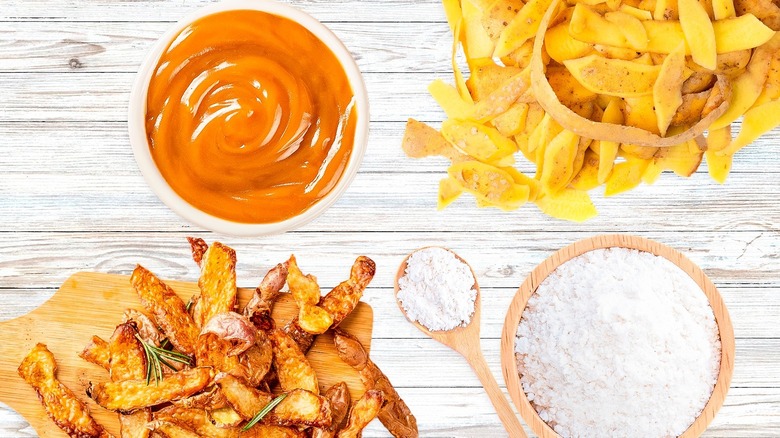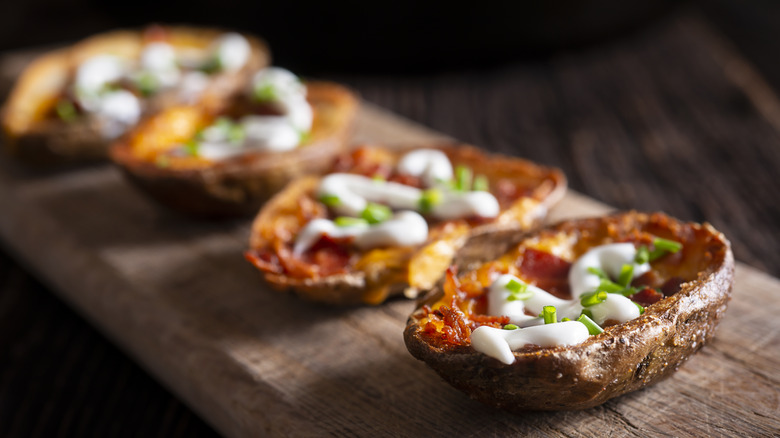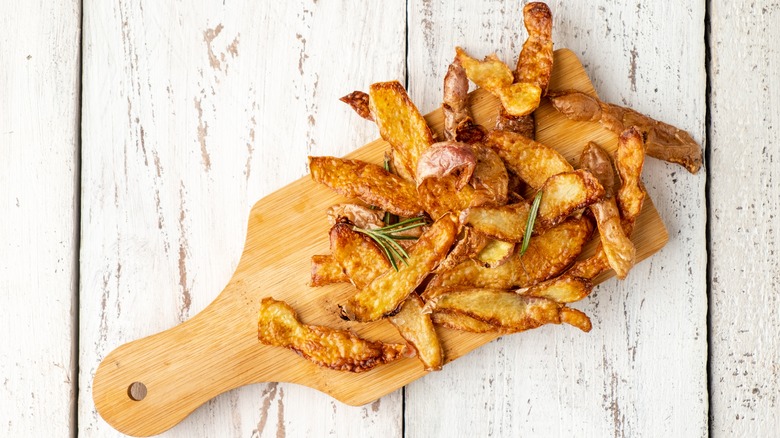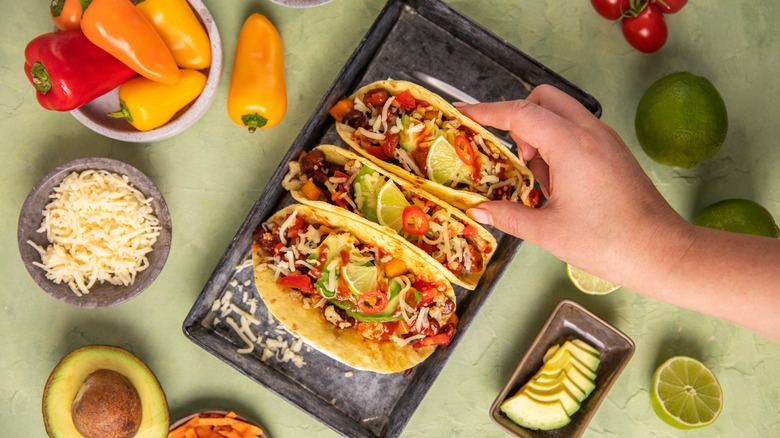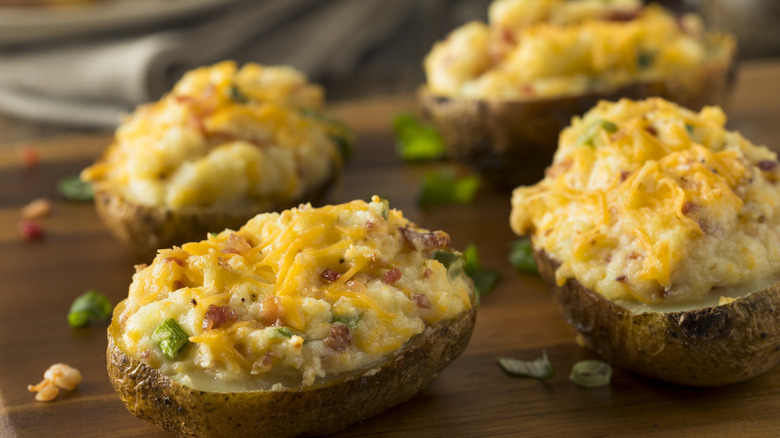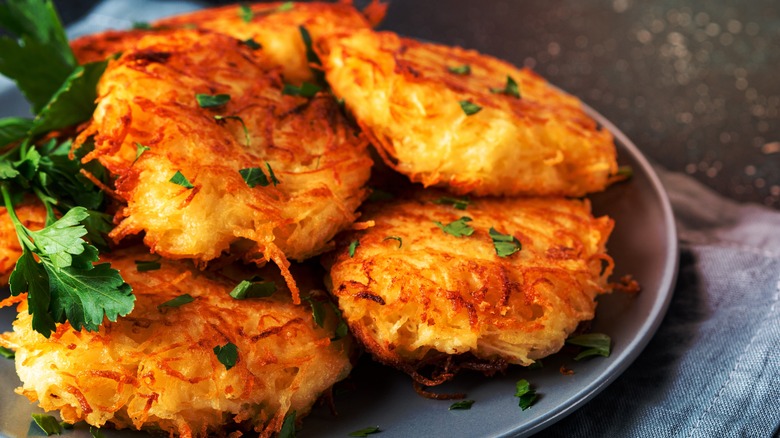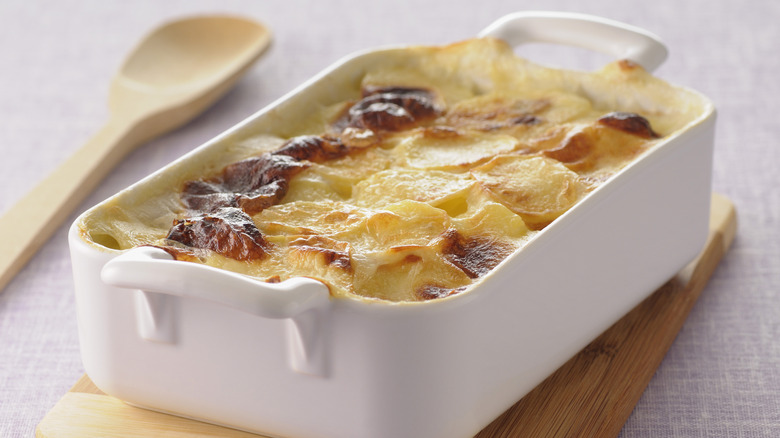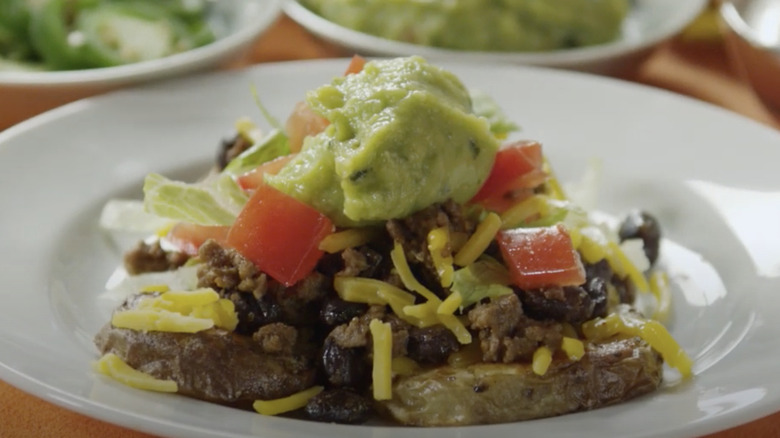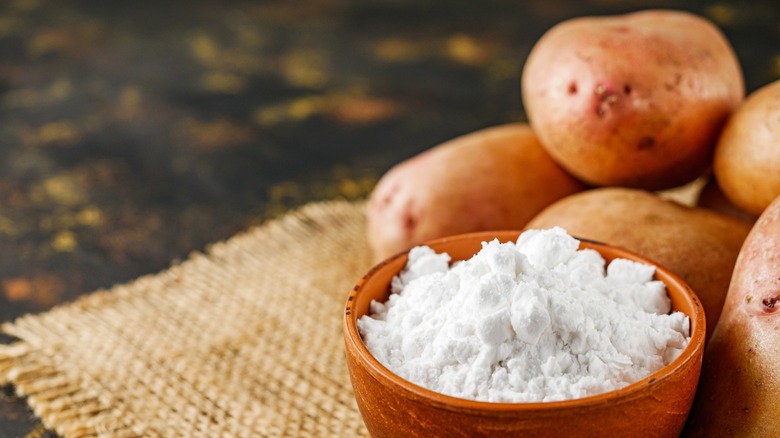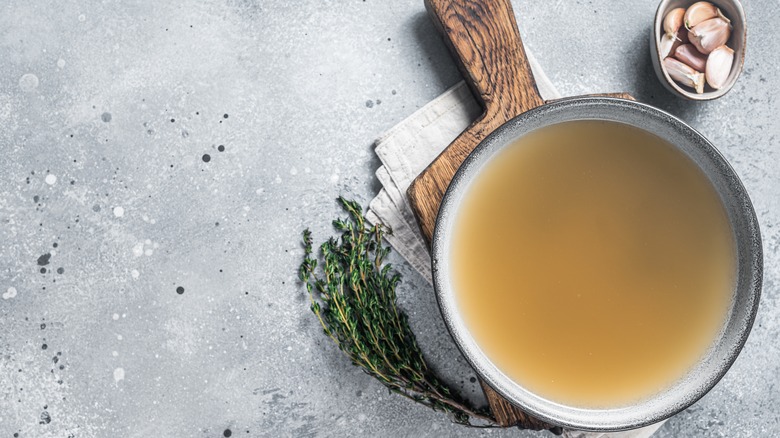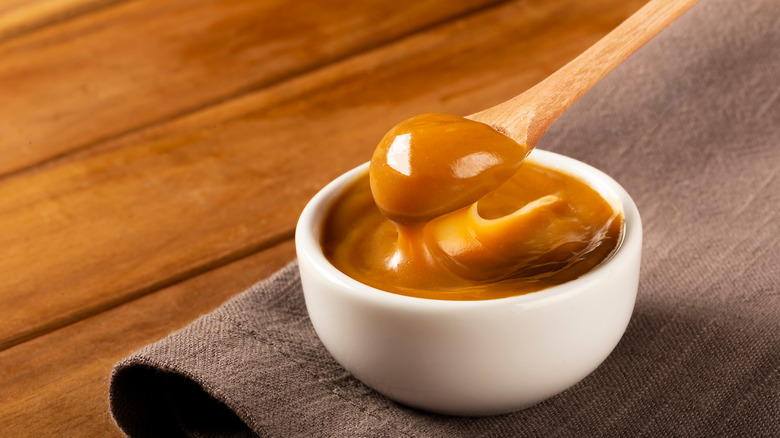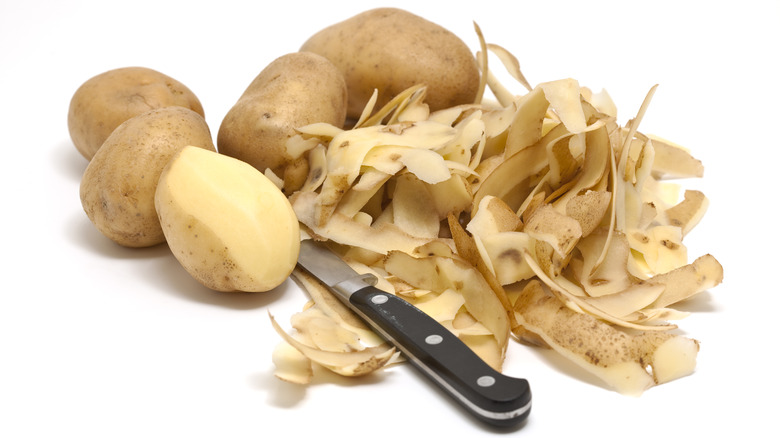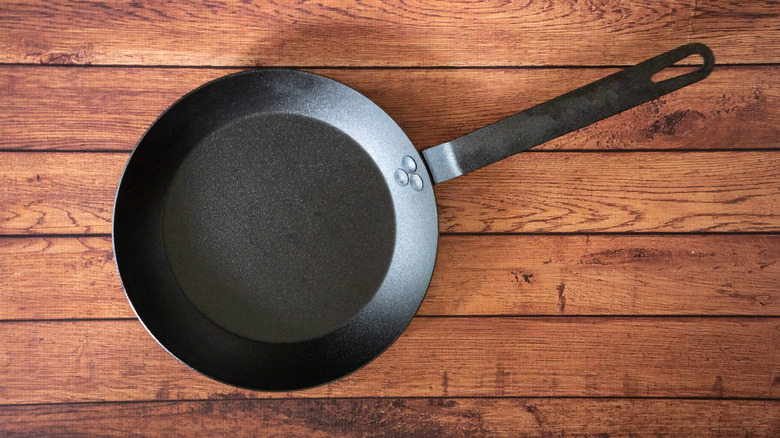16 Creative Ways To Use Potato Peels
Cooking is not just about making delicious food — it's about learning how to take full advantage of what an ingredient has to offer. One thing you learn is that many of the leftovers thrown away during preparation can be reused in other ways, which helps you be more mindful during the cooking process and expand your skills. According to Feeding America, 38% of all food in the United States is wasted each year. While there are numerous contributing factors outside of your immediate control, adopting a sustainable approach to reduce throwing out food at home is a step that everyone can take.
You'd be surprised what you can conjure in the kitchen with ingredient leftovers. Take potato peels, for example. They are perfectly edible, yet commonly thrown away. Along with having a wide range of culinary uses, most people aren't aware that potato peels contain more dietary fiber and antioxidants than the flesh itself. Suffice it to say, you've been missing out on this versatile leftover. Beyond its nutritional value, it can provide texture or be turned into an entirely new dish. Here are some sustainably creative ways to use potato peels.
Enjoy potato peels as a game day treat
A legendary game-day staple, baked potato peels pack the perfect fuel for boisterous fans. The Chicago-based restaurant R.J. Grunts was one of the first places to offer potato skins. The inspiration allegedly stems from a radio show that aired during the early '70s, mentioning it as a nutritious go-to for sailors hoping to lower the chances of getting sick. R.J. Grunts is one of three restaurants credited with inventing potato skins. Whichever is the original, each deserves plaudits for preventing countless hangovers.
There's a method to baking perfect potato peels, but patience is the most important thing you need. It's one of those recipes that gets better with more oven time. You'll bite into a soggy and tough consistency if your cravings compel you to take it out prematurely. The type of potato you use matters as well. We recommend russets based on their size and surface space for ingredients. Use copious amounts of oil to give your baked potatoes a crispy skin. That'll make them sturdy enough for the tasty toppings of your choosing.
Broil for an extra crispy consistency
After impressing friends with your baked potato peels, turn the heat up for an extra crisp. Crunch not only adds texture, but it may actually cause your brain to react in surprising ways. According to a Well+Good interview, gastrophysicist Dr. Charles Spence, Ph.D. shared the theory that the human brain may associate crunchiness with freshness. Eating crunchy foods also requires paying more attention — whereas mushy foods are quiet, a crackly sound impacts the experience.
Using a broiler is the ticket to crispy potato peels that satisfy your crunch cravings. Simply add it as an additional step to your regular recipe. Along with a delectable consistency, the fiery touch provides a layer of char that elevates each ingredient to mouthwatering heights. If you're wondering what to do with the discarded flesh, test the limits of tastiness with twice-baked potatoes. You'll need a few dedicated hours for baking, but we promise that you won't regret the wait.
Snack on crunchy potato peel chips
Crunch-iphiles needn't worry, as there is a method for making potato peels super crispy. Loaded potato skins are undeniably delicious, but why not do away with toppings, and instead, transform leftover peels into chips? It's a quick, delicious, and nutritious way to reduce waste. Along with the potato-y taste you love, the peel contains 88% of a tuber's total iron. Iron is an essential vitamin that increases your body's overall energy and mental focus.
Nutrients aside, potato peel chips are great for those with busy schedules, parents with hangry kids, or simply those looking for a quick snack. There are multiple ways to crunch-ify your potato peels, too. With a little oil and salt, an air fryer will give peels an ideal crisp. If your kitchen isn't stocked with fancy cookware, roasting in an oven will more than suffice. Cooking is the easy part though, the fun part is choosing how to flavor them. Sprinkle your favorite combination of seasonings, pull out a savory dipping sauce, and snack away.
Use as a savory filling for tacos
Versatility is the best thing about tacos. They are completely customizable, which means that there is no shortage of taco styles to experience. A little culinary exploration never hurts either. Whether you're a purist who sticks to tradition or an adventurous taco lover, an empty tortilla is an opportunity to express your palate. You'll be surprised to find that potato peels are an awesome substitute filling for meat. Besides being vegetarian and vegan-friendly, they can also be used to add texture to your favorite taco fillings.
Fried potato peel tacos should definitely be on your culinary bucket list. In the motherland of tacos, tacos de pobre (or poor tacos) are a popular Mexican street food. Super cheap yet rich in flavor, the idea was borne out of working-class ingenuity. Whether you wear steel toes to work or use money for toilet paper, fried potato peel tacos are a meal that everyone can enjoy. Pair the potato peel filling with your go-to ingredients to marry the best of both crunchy and chewy worlds.
Put a sweet plant-based spin on bacon
Another potato peel hack is turning them into plant-based bacon. Before you press the eject button though, hear us out. Like regular potatoes, sweet potato peels are equally as useful — but unlike them, they carry a subtle sweetness. They can be used as an alternative to the above options as well, which gives you even more of a reason to reuse your leftover peels. Although sweet, this tuber pairs nicely with savory flavors. It's easy to make sweet potato peel bacon – all you need are a few ingredients.
After removing the peels, place them on a baking sheet and lather each strip with coconut aminos and liquid smoke. If you've never had coconut aminos, it's a popular alternative to soy sauce that has a similar flavor. Liquid smoke will provide the savory smoked flavor that bacon is known for. For the final touch, season and roast in the oven at 400 degrees F for 25 minutes. Serve it alongside breakfast staples to fully suspend disbelief.
Overindulge on twice-baked potatoes
A flawless baked potato is like biting into a puffy cloud of deliciousness. They are the pot of gold waiting for patient home chefs at the end of the culinary rainbow. And thanks to someone truly virtuous, twice-baked potatoes exist. They take twice as long to bake and are twice as tasty. Beautiful and bulbous, the sight alone is enough to inspire hunger pangs. Making twice-baked potatoes is a sustainable and flavorful way to use both the flesh and the skin. It's like combining mashed, baked, and potato skins all into one scrumptious meal.
Apart from the cooking time, they are arguably superior to regular baked potatoes in every way. You can put the twice-baked touch on any recipe and enjoy it for the main course or as a hearty side dish. To ride the elevator up to the next level of baked potatoes, make sure to set aside at least 2 ½ hours.
Amp up mornings with potato peel hash browns
As the most important meal of the day, a bad breakfast can make it hard to carpe your diem. Potatoes and breakfast go together like popcorn and movies, and of all the potato-based breakfast staples, a carefully crisped hash brown is the prettiest sight to behold. Its crunchy exterior and tender shredded flesh are the perfect complement to eggs and bacon. If you love homemade hash browns, just wait until you try making them with potato peels.
Using leftover peels gives you the option of serving two separate potato dishes for breakfast. You can remove the peel and chop potatoes into cubes for home fries, then save the peels for hash browns the following morning. The preparation is identical too — simply chop the skins into small strips and cook them in a pan with oil. Potatoes are fairly cheap, but squeezing two meals out of them is always better than one.
Add texture to creamy dishes
From mashes and casseroles to soups and pasta, there are countless creamy dishes to enjoy. The biggest problem with creamy dishes is that they quickly become boring to the tongue. Although undeniably crave-worthy, the flavor profile gradually wears away at your tastebuds, melding into one solid mass of sameness. Rather than a one-note experience, texture introduces complexity to the arrangement. Ice cream is amazing alone, but with ingredients like nuts, chocolate chips, or fruit, the potential is limitless.
Potato peels can add texture to creamy dishes too. They can be incorporated into classic soups, pastas, sauces, casseroles, and more. If ground fine enough, you can even layer salads or macaroni and cheese with potato peels as a breadcrumb replacement. The best part about this texture trick is that it works for all potato varieties. Making these pseudo breadcrumbs is easy, too — you can roast them in the oven, or fry them in a stovetop pan.
Celebrate game day with potato peel nachos
Break from game day tradition with potato peel nachos. It's a clever approach to a crave-tastic classic and the perfect alternative to regular loaded potato skins. The recipes are identical, the only difference is that peel nachos are loaded as one rather than individually — and even better, finished with a healthy drizzle of queso. The usual cast of ingredients are present: white onion, diced tomato, and jalapeño, along with chopped garlic and cilantro. Flavor-rich bacon bits and a mouthwatering combination of cheddar, Monterey Jack, and creamy queso up the ante on this dish.
Potato peel nachos are arguably better for gatherings than traditional nachos. The potato is more filling than tortilla chips, which means that you can stretch it longer because people will get full faster. Potatoes and tortilla chips are both neutral-flavored, giving you more freedom to experiment with different toppings. Regular nachos top the potato peel variety in only one area: They take less time to cook.
Transform into potato powder
Grinding your leftover potato peels into a powder is probably the last thing that you'd think to do. The process is more involved than simply cutting and baking, but the reward is a cooking ingredient that has a wide range of uses. Whip out your blender, food processor, or mortar and pestle. Making potato powder requires a dehydrator too, but fancy cookware aside, it's pretty easy to make. You can reduce food waste considerably with a dehydrator by turning leftover ingredients into powder.
Potato powder, also known as potato flour, can be blended into liquid-based recipes as a thickening agent. From savory gravies to flavorful sauces, it's super useful and can even be used to bake potato bread. Once turned into powder, it can last for up to six months if properly stored. The pantry, cabinet, or someplace that's dry and shielded from direct sunlight are the most ideal storage spaces.
Infuse vegetable broth with potato-y flavor
Much like potato peel powder can be used to thicken and flavor sauces, it can be added to vegetable broth for a richer consistency. There are some things to keep in mind though, the first being the amount you use. If you add potato peel powder too soon in the cooking process or use too much of it, it could spell doom for your broth. Moderation is key — we suggest waiting until the final 10 minutes before adding it to the pot.
Introducing it sooner increases the chances of the powder's starch content making the liquid cloudy and bitter tasting. It only needs just about 10 minutes for the potato flavor to infuse the liquid. Homemade broth is a great alternative to store-bought, which is often loaded with sodium. It can last a little under a week stored in a fridge and for almost 6 months in the freezer.
Blend into mashed potatoes for texture
The jury's out on which mashed potato style is superior: Skin-in or skinless. One could argue that the skin-in variety is more nutritious, as mashed potatoes can be a butter-filled excursion. Skinless mashed potatoes rule in the taste department though. Creamy garlicky goodness often trumps health, for better or for worse. Luckily, there's a way to enjoy the best that both worlds have to offer. Rather than using whole potato peels, you can grind them into a powder that can be used for texture.
The idea is similar to pre-packaged dehydrated mashed potatoes, but infinitely better for your tongue and tummy. Unlike store-bought, you can adjust the fineness of the grind to your preference to give mashed potatoes a custom crunch. Whereas peelings can add an undesirable stringy consistency, potato powder melds seamlessly when eaten. Serve it at your next dinner party to help Teams Skin-in and Skinless settle the debate.
Transform peels into sweet potato milk jam
If you thought potato peel powder was interesting, just wait until you try potato milk jam. Milk jam is another name for dulce de leche, a custard-like spread of caramelized milk and sugar. It's one of many variations that you can find around the globe, transforming potato peels into the unlikeliest of desserts. A British chef and TV personality named Heston Blumenthal is the brainchild behind the idea. In an episode of his show "How to Cook Like Heston," Blumenthal demonstrated how roasted potato peels can be made into a creamy potato-flavored jam.
With a super simple learning curve, you'll be spreading potato peel milk jam on everything. Surprisingly, the process involves oil and salt too, but only for the roasting part. The rest is pretty identical to the traditional method: Simmer the roasted potato skins in milk and sugar for several hours. Strain out any remaining potato pieces and prepare for sweeter days ahead.
Bake a hearty potato peel pie
Potato peel pie sounds like a head-scratcher doesn't it? The idea comes from a movie named "The Guernsey Literary and Potato Peel Pie Society," which was inspired by events that followed World War II. During the German occupation, resourcefulness was the only means of survival. The people responded to a food shortage by coming up with things like potato peel pie. While there is no proof that potato peel pie existed back then, the idea is endearing enough to try to recreate at home.
It's a simple dish that only requires three ingredients: potatoes, beetroot, and milk. Doesn't sound too appealing, does it? Well, before you discount it entirely, hear us out. The potato peels are used in place of pie crust and filled with mashed potato and chopped beetroot. Of course, you'll need to spruce this humble recipe up with seasoning. You can pull out the usual baked potato go-tos or opt for a simple combination of butter, salt, pepper, and chives.
Give your carbon steel pan a potato peel seasoning
Cookware maintenance can not only sustain the quality of your cooking tools, but it can also improve the food you make. Cast iron and carbon steel cookware require more attention than those made from other materials. The most important step before using either is to season them thoroughly. Seasoning involves adding a protective layer of oil to your pots and pans that prevents them from rusting and foods from easily sticking. While oil alone can handle the job, pairing it with potato peels can improve the overall seasoning job.
Unlike cast iron, there's an additional step when seasoning carbon steel cookware. If it's brand spanking new, the wax coating must be removed first. You can begin the actual seasoning once it's wax-free. For a medium-sized pan, use two potatoes, ⅓ cup of oil, and ⅔ cup of salt. Potato peels help the heat distribute more evenly, which lowers the chances of lumps in the seasoning layer. You can adjust the potato count to the size of the pot or pan. The whole process should last no longer than 15 minutes, give or take.
Brew homemade batch of potato vodka
Delicious eats aren't the only ways to reuse potato peels — skip the liquor run and brew yourself a buzzy homemade batch of vodka. While most people know that vodka is made from potatoes, you can extract a good time from the peels too. Talking about sustainable spirits, according to Leaf TV, potato peel waste can produce premium vodka when fermented with molasses and yeast. Unlike the traditional potato vodka method, it doesn't require a still, which is used to distill liquid mixtures.
Before you can unlock a barrel of fun, an important thing to take note of is whether the potato skins are fresh or cooked. You'll need a 4-liter bucket, 2 liters of water, 1 lb. of potato skins, ½ lb. of molasses, and ¼ lb. of yeast for the mixture. Seal the bucket and place it in a cool dry place to ferment. After a week or s0, the yeast will break down the peels and infuse them into the liquid, which means that the liquid is ready to be strained and sipped.
